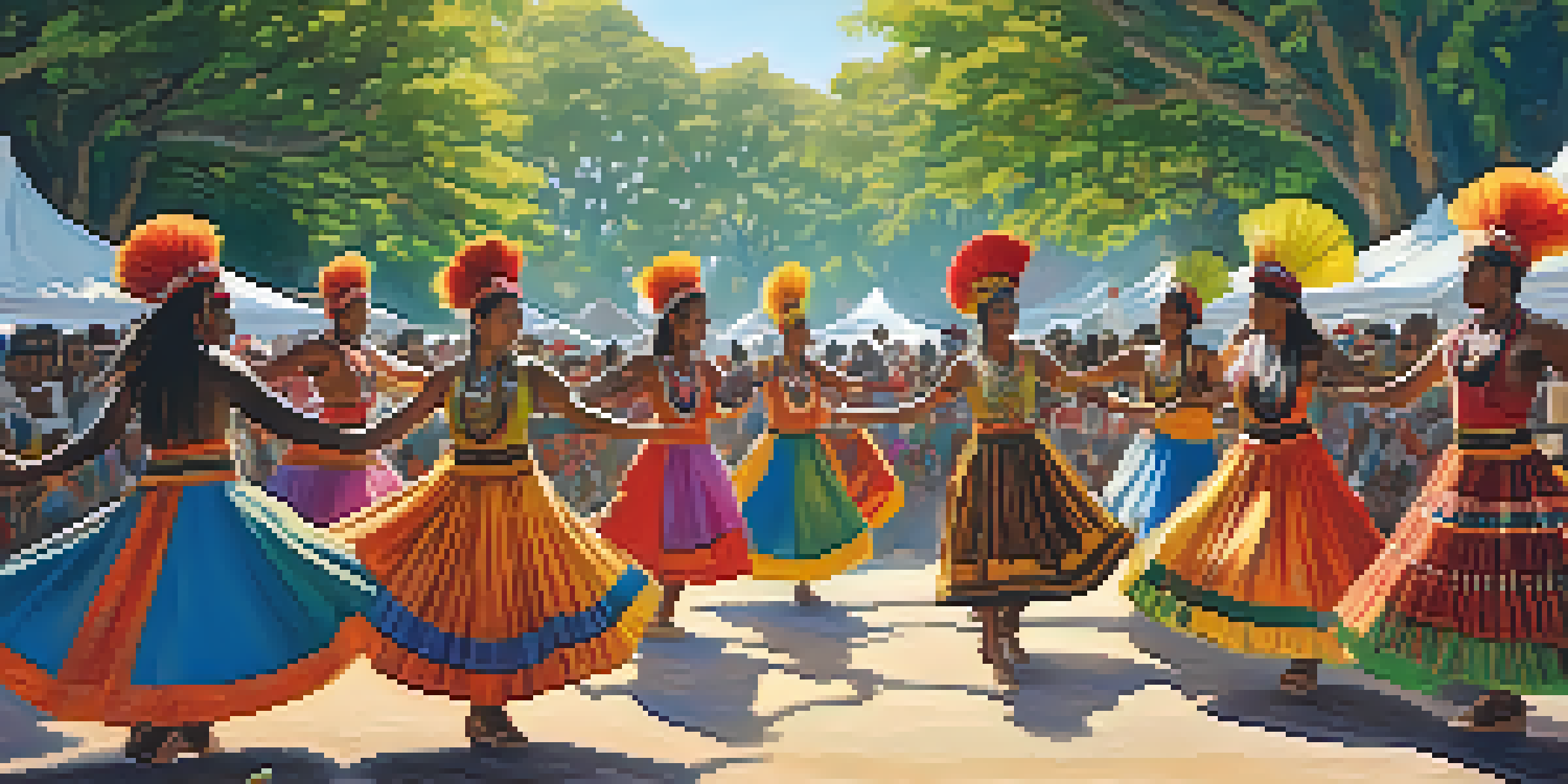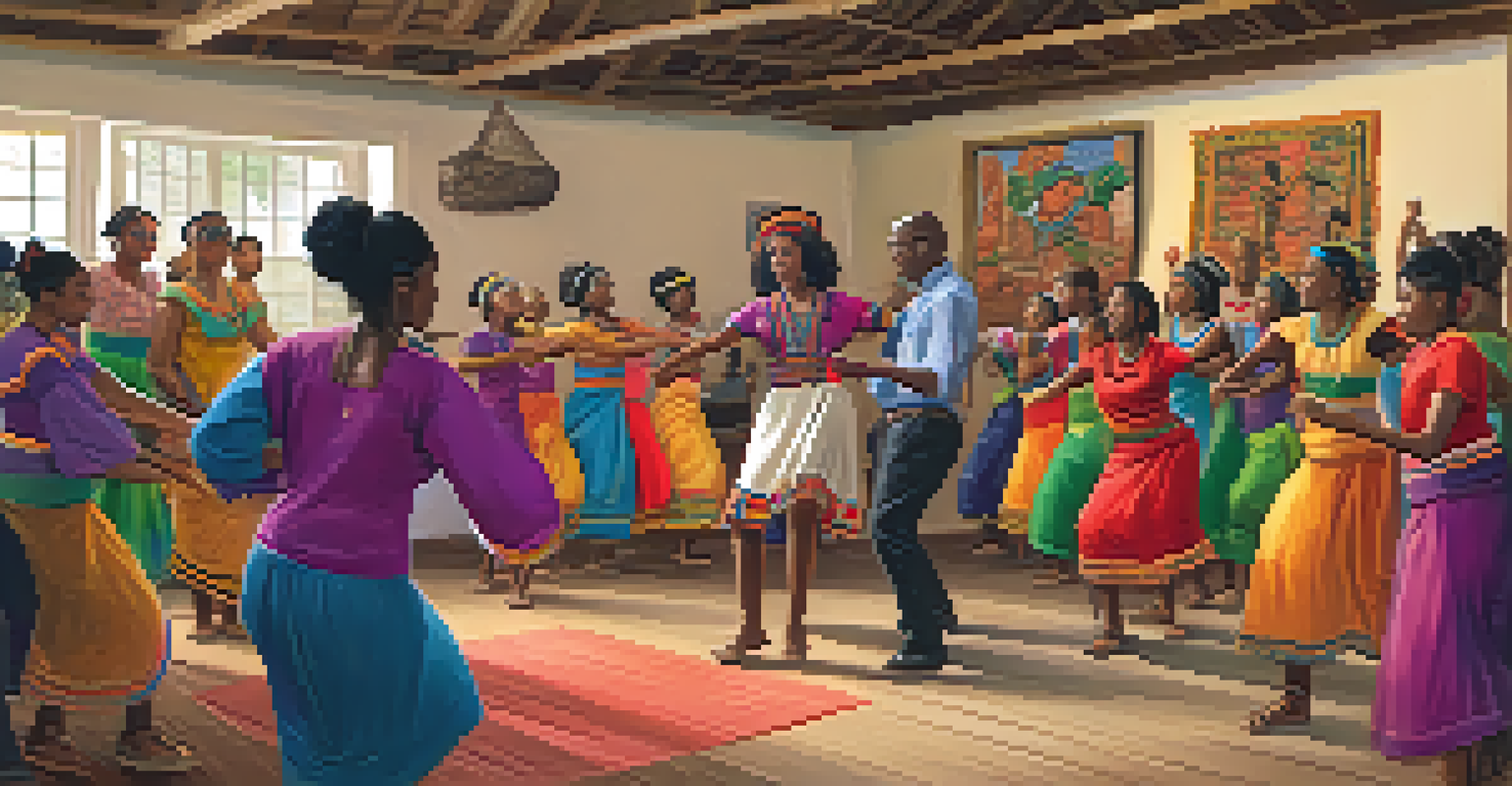Celebrating Diversity: Indigenous and Afro-Peruvian Dances

The Importance of Dance in Indigenous Cultures
Dance has long served as a vital expression of identity in Indigenous cultures. Through rhythmic movements and vibrant costumes, these dances convey stories, traditions, and spiritual beliefs. Each step and gesture carries the weight of history, allowing communities to preserve their heritage.
Dance is the hidden language of the soul.
For many Indigenous groups, dance is not just entertainment; it is a form of communication with ancestors and the natural world. Ceremonial dances often mark significant life events, such as harvests, weddings, or rites of passage, fostering a sense of community and continuity.
By participating in these dances, individuals not only honor their ancestors but also educate younger generations about their cultural roots. This passing down of knowledge helps ensure that these traditions remain vibrant and relevant in a rapidly changing world.
A Glimpse into Afro-Peruvian Dance Traditions
Afro-Peruvian dances are a beautiful testament to the rich cultural blend that characterizes Peru's history. Rooted in the African diaspora, these dances incorporate lively rhythms and unique movements that reflect the struggles and triumphs of Afro-Peruvian communities. Popular styles include the ' festejo' and 'landó', each with its own distinct flair.

These dances often celebrate themes of resilience, love, and community, showcasing the vibrant spirit that has emerged from historical challenges. The use of drums, clapping, and call-and-response patterns creates an infectious energy, drawing everyone into the celebration.
Dance Preserves Cultural Identity
Indigenous and Afro-Peruvian dances serve as vital expressions of identity, conveying stories and traditions that connect communities to their heritage.
Afro-Peruvian dance has gained recognition not only as an art form but also as a means of cultural expression. Festivals and performances highlight these traditions, fostering pride and awareness among both performers and audiences.
Cultural Fusion: Where Indigenous and Afro-Peruvian Dances Meet
The intersection of Indigenous and Afro-Peruvian dance traditions is a captivating example of cultural fusion. This blending occurs naturally in many communities, where different backgrounds contribute to a shared identity. The result is a rich tapestry of dance styles that draw from various influences.
The dance is a poem of which each movement is a word.
This fusion not only enriches the dances themselves but also helps to foster mutual understanding and respect among diverse groups. Celebrating both Indigenous and Afro-Peruvian heritage encourages collaboration and creates a unified cultural narrative.
Events that showcase this blend provide opportunities for cross-cultural dialogue and appreciation. By embracing these diverse dance forms, communities can celebrate their shared history while honoring their unique stories.
The Role of Festivals in Preserving Dance Traditions
Festivals play a vital role in the preservation and promotion of Indigenous and Afro-Peruvian dances. These vibrant gatherings bring together dancers, musicians, and audiences, creating an atmosphere of celebration and cultural exchange. Events like the Festival de la Marinera and the Afro-Peruvian Festival highlight the significance of dance in daily life.
During these festivals, traditional dances are performed alongside contemporary interpretations, showcasing the evolution of these art forms. This blend of old and new not only captivates audiences but also encourages younger generations to engage with their cultural heritage.
Festivals Celebrate Dance Traditions
Cultural festivals play a crucial role in promoting and preserving dance traditions, offering platforms for education, celebration, and intergenerational engagement.
Additionally, festivals serve as platforms for education and awareness, allowing attendees to learn about the historical and cultural contexts of the dances. By participating in these events, individuals contribute to the ongoing celebration of diversity in Peru.
Dance as a Medium for Social Change
Dance can be a powerful tool for social change, particularly within Indigenous and Afro-Peruvian communities. Through performances and workshops, dancers can raise awareness about pressing social issues, such as discrimination and inequality. This engagement fosters a sense of solidarity and empowerment among marginalized groups.
By addressing these challenges through art, dancers create space for dialogue and reflection. Their performances often highlight the struggles faced by their communities, inspiring others to take action and advocate for change.
Moreover, initiatives that promote dance education can help uplift communities by providing opportunities for artistic expression. This empowerment through dance not only enriches individual lives but also strengthens community bonds.
The Global Impact of Indigenous and Afro-Peruvian Dances
The influence of Indigenous and Afro-Peruvian dances extends far beyond Peru’s borders. As these dance forms gain popularity internationally, they introduce global audiences to the rich cultural narratives they embody. This exposure fosters appreciation and understanding of the diverse backgrounds from which they originate.
International collaborations and performances allow dancers to share their cultural heritage while also learning from others. This exchange of ideas and styles contributes to the evolution of dance as an art form, creating new opportunities for creativity and expression.
Dance as a Tool for Social Change
Dance empowers marginalized communities by raising awareness of social issues, fostering solidarity, and encouraging dialogue through artistic expression.
Through global recognition, Indigenous and Afro-Peruvian dances can gain support for preservation efforts. Increased awareness can lead to funding and resources aimed at safeguarding these traditions for future generations.
How to Experience Indigenous and Afro-Peruvian Dances Today
For those eager to experience Indigenous and Afro-Peruvian dances firsthand, numerous opportunities are available. Attending local festivals and cultural events provides a lively and immersive way to connect with these traditions. Many cities around the world host events featuring these dances, allowing people to witness their beauty and significance.
Additionally, workshops and classes are offered in various communities, where you can learn the movements and rhythms that make these dances so special. Engaging in these activities not only enhances your understanding but also fosters a deeper appreciation for the cultures they represent.

Lastly, consider supporting organizations that promote and preserve Indigenous and Afro-Peruvian dance traditions. By doing so, you can contribute to the ongoing celebration of diversity and help ensure that these vibrant cultural expressions continue to thrive.